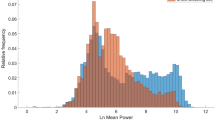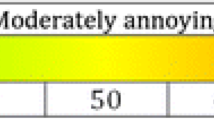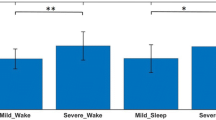Abstract
In a multidimensional feature space, the snoring sounds can extend from a very compact cluster to highly distinct clusters. In this study, we investigated the cause of snoring sound’s variation within the snorers. It is known that a change in body position and sleep stage can affect snoring during sleep but it is unclear whether positional, sleep state, and blood oxygen level variations cause the snoring sounds to have different characteristics, and if it does how significant that effect would be. We extracted 12 characteristic features from snoring sound segments of 57 snorers and transformed them into a 4-D feature space using principal component analysis (PCA). Then, they were grouped based on the body position (side, supine, and prone), sleep stage (NREM, REM, and Arousal), and blood oxygen level (Normal and Desaturation). The probability density function of the transformed features was calculated for each class of categorical variables. The distance between the class-densities were calculated to determine which of these parameters affects the snoring sounds significantly. Analysis of Variance (ANOVA) was run for each categorical variable. The results show that the positional change has the highest effect on the snoring sounds; it results in forming distinct clusters of snoring sounds. Also, sleep state and blood oxygen level variation have been found to moderately affect the snoring sounds.





Similar content being viewed by others
References
Hoffstein V (2002) Apnea and snoring: state of the art and future directions. Acta Otorhinolaryngol Belg 56:205–236
Martikainen K, Partinen M, Urponen H, Vuori I, Laippala P, Hasan J (1994) Natural evolution of snoring: a 5-year follow-up study. Acta Neurol Scand 90:437–442
Azarbarzin A, Moussavi Z (2011) Automatic and unsupervised snore sound extraction from respiratory sound signals. IEEE Trans Biomed Eng 58:1156–1162
Cavusoglu M, Kamasak M, Erogul O, Ciloglu T, Serinagaoglu Y, Akcam T (2007) An efficient method for snore/nonsnore classification of sleep sounds. Physiol Meas 28:841–853
Herzog M, Bremert T, Herzog B, Hosemann W, Kaftan H, Müller A (2011) Analysis of snoring sound by psychoacoustic parameters. Eur Arch Otorhinolaryngol 268:463–470
Hill P, Lee B, Osborne J, Osman E (1999) Palatal snoring identified by acoustic crest factor analysis. Physiol Meas 20(2):167–174
Won T, Kim SY, Lee WH, Han DH, Kim D, Kim J, Rhee C, Lee CH (2012) Acoustic characteristics of snoring according to obstruction site determined by sleep videofluoroscopy. Acta Otolaryngol 132:S13–S20
Polo OJ, Tafti M, Fraga J, Porkka KVK, Dejean Y, Billiard M (1991) Why don’t all heavy snorers have obstructive sleep apnea? Am J Respir Crit Care Med 143:1288–1293
Abeyratne U, Wakwella A, Hukins C (2005) Pitch jump probability measures for the analysis of snoring sounds in apnea. Physiol Meas 26:779–798
Ng A, Koh T, Abeyratne U, Puvanendran K (2009) Investigation of obstructive sleep apnea using nonlinear mode interactions in nonstationary snore signals. Ann Biomed Eng 37:1796–1806
Ng AK, Koh TS, Baey E, Puvanendran K (2009) Role of upper airway dimensions in snore production: acoustical and perceptual findings. Ann Biomed Eng 37(9):1807–1817
Mesquita J, Solà-Soler J, Fiz JA, Morera J, Jané R (2012) All night analysis of time interval between snores in subjects with sleep apnea hypopnea syndrome. Med Biol Eng Comput 50:373–381
Solà-Soler J, Fiz JA, Morera J, Jané R (2012) Multiclass classification of subjects with sleep apnoea-hypopnoea syndrome through snoring analysis. Med Eng Phys 34(9):1213–1220
Karunajeewa AS, Abeyratne UR, Hukins C (2011) Multi-feature snore sound analysis in obstructive sleep apnea—hypopnea syndrome. Physiol Meas 32:83–97
Ng AK, Koh TS, Baey E, Puvanendran K (2007) Diagnosis of obstructive sleep apnea using formant features of snore signals. In: Proceedings of world congress on medical physics and biomedical engineering 2006, IFMBE, vol 14, pp 967–970
Abeyratne U, Karunajeewa A, Hukins C (2007) Mixed-phase modeling in snore sound analysis. Med Bio Eng Comput 45:791–806
Cavusoglu M, Ciloglu T, Serinagaoglu Y, Kamasak M, Erogul O, Akcam T (2008) Investigation of sequential properties of snoring episodes for obstructive sleep apnoea identification. Physiol Meas 29:879–898
Azarbarzin A, Moussavi Z (2012) Snoring sounds variability as a signature of obstructive sleep apnea. Med Eng Phys. doi:10.1016/j.medengphy.2012.06.013
Azarbarzin A, Moussavi Z (2012) A comparison between recording sites of snoring sounds in relation to upper airway obstruction. In: Engineering in medicine and biology society (EMBC), Annual international conference of the IEEE, pp 4246–4249
Nakano H, Ikeda T, Hayashi M, Ohshima E, Onizuka A (2003) Effects of body position on snoring in apneic and nonapneic snorers. Sleep 26(2):169–172
Pevernagie D, Aarts RMMeyer MD (2010) The acoustics of snoring. Sleep Med Rev 14:131–144
Perez-Padilla J, Slawinski E, Difrancesco L, Feige R, Remmers J, Whitelaw W (1993) Characteristics of the snoring noise in patients with and without occlusive sleep apnea. Am Rev Respir Dis 147(3):635–644
Herzog M, Kühnel T, Bremert T, Herzog B, Hosemann W, Kaftan H (2009) The impact of the microphone position on the frequency analysis of snoring sounds. Eur Arch Otorhinolaryngol 266:1315–1322
Huang X, Acero A, Hon H (2001) Formant frequencies. In: Spoken language processing: a guide to theory, algorithm and system development. Prentice Hall PTR, New Jersey, pp 319–324
Hurvich CM, Tsai C (1993) A corrected Akaike information criterion for vector autoregressive model selection. J Time Ser Anal 14:271–279
Inouye T, Shinosaki K, Sakamoto H, Toi S, Ukai S, Iyama A, Katsuda Y, Hirano M (1991) Quantification of EEG irregularity by use of the entropy of the power spectrum. Electroencephalogr Clin Neurophysiol 79:204–210
Proakis JG, Manolakis DK (2006) Power spectrum estimation. In: Digital signal processing, 4th edn, Prentice Hall, New Jersey
Cohen ME, Hudson DL, Deedwania PC (1996) Applying continuous chaotic modeling to cardiac signal analysis. Eng Med Biol Mag IEEE 15:97–102
Jolliffe L (2002) Principal component analysis. Springer-Verlag, Inc., New York
BW Silverman (1986) Density estimation for statistics and data analysis. Chapman and Hall, New York
Devroye L, Györfi L (1985) Nonparametric density estimation: the L1 view. Wiley, New York, p 356
Theodoridis S, Koutroumbas K (2008) Feature selection. In: Pattern recognition, 4th edn. Academic Press, USA, pp 275–276
Burden RL, Faires JD (2005) Numerical differentiation and integration. In: Numerical analysis. Thomson Brooks/Cole, California, pp 167–247
Searle SR (1971) Models not of full rank. In: Linear Mmdels. Wiley, New York, pp 164–225
Pevernagie D, Stanson A, Sheedy P, Daniels B, Shepard J (1995) Effects of body position on the upper airway of patients with obstructive sleep apnea. Am J Respir Crit Care Med 152(1):179–185
Gabriel KR (1971) The biplot graphic display of matrices with application to principal component analysis. Biometrika 58:453–467
Ayappa I, Rapoport D (2003) The upper airway in sleep: physiology of the pharynx. Sleep Med Rev 7(1):9–33
Acknowledgments
The authors would like to acknowledge and thank Dr. Eleni Giannouli for her input and the invaluable help in data collection. The authors also thank Natural Sciences and Engineering Research Council (NSERC) of Canada and Telecommunication Research Labs (TRLabs) of Manitoba for financial support.
Author information
Authors and Affiliations
Corresponding author
Rights and permissions
About this article
Cite this article
Azarbarzin, A., Moussavi, Z. Intra-subject variability of snoring sounds in relation to body position, sleep stage, and blood oxygen level. Med Biol Eng Comput 51, 429–439 (2013). https://doi.org/10.1007/s11517-012-1011-8
Received:
Accepted:
Published:
Issue Date:
DOI: https://doi.org/10.1007/s11517-012-1011-8




